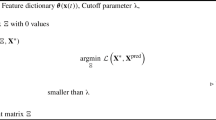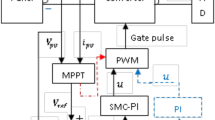Abstract
The problem of state and parameter estimation for a class of second-order time-varying systems is addressed in this paper. Two classes of estimators are designed for the system under different observability assumptions. The design procedure is based on a filtered transformation via dynamic matrix. The dynamic of the matrix is derived using the Immersion and Invariance technique. Adaptive parameter convergence is guaranteed under a weaker condition than traditional persistency of excitation, called non-square-integrability condition. The proposed estimator is shown to be applicable to the input voltage and current estimation from the output voltage of the AC-DC boost converter.
Similar content being viewed by others
References
R. Ortega and Y. Tang, “Robustness of adaptive controllersa survey,” Automatica, vol. 25, pp. 651–677, 1989.
Y. Pan and H. Yu, “Composite learning robot control with guaranteed parameter convergence,” Automatica, vol. 89, pp. 398–406, 2018.
G. Chowdhary, M. Mühlegg, and E. Johnson, “Exponential parameter and tracking error convergence guarantees for adaptive controllers without persistency of excitation,” International Journal of Control, vol. 87, pp. 1583–1603, 2014.
Y. Pan and H. Yu, “Composite learning from adaptive dynamic surface control,” IEEE Transactions on Automatic Control, vol. 61, pp. 2603–2609, 2016.
S. Aranovskiy, A. Bobtsov, R. Ortega, and A. Pyrkin, “Performance Enhancement of Parameter Estimators via Dynamic Regressor Extension and Mixing,” IEEE Transactions on Automatic Control, vol. 62, pp. 3546–3550, 2017.
Y. Pan, L. Pan, M. Darouach, and H. Yu, “Composite learning: An efficient way of parameter estimation in adaptive control,” Proc. of 35th Chinese Control Conference (CCC), pp. 3280–3285, 2016.
N. Barabanov and R. Ortega, “On global asymptotic stability of with φ not persistently exciting,” Systems & Control Letters, vol. 109, pp. 24–29, 2017.
J. Wang, S. Aranovskiy, A. A. Bobtsov, A. A. Pyrkin, and S. A. Kolyubin, “A method to provide conditions for sustained excitation,” Automation and Remote Control, vol. 79, pp. 258–264, 2018.
S. Aranovskiy, A. Bobtsov, R. Ortega, and A. Pyrkin, “Improved transients in multiple frequencies estimation via dynamic regressor extension and mixing,” IFAC-PapersOnLine, vol. 49, pp. 99–104, 2016.
A. Bobtsov, D. Bazylev, A. Pyrkin, S. Aranovskiy, and R. Ortega, “A robust nonlinear position observer for synchronous motors with relaxed excitation conditions,” International Journal of Control, vol. 90, pp. 813–824, 2017.
A. Pyrkin, F. MancillaDavid, R. Ortega, A. Bobtsov, and S. Aranovskiy, “Identification of photovoltaic arrays’ maximum power extraction point via dynamic regressor extension and mixing,” International Journal of Adaptive Control and Signal Processing, vol. 31, no. 9, pp. 1337–1349, Sep. 2017.
D. Bazylev, S. Vukosavic, A. Bobtsov, A. Pyrkin, A. Stankovic, and R. Ortega, “Sensorless control of PM synchronous motors with a robust nonlinear observer,” IEEE Industrial Cyber-Physical Systems (ICPS), pp. 304–309, 2018.
D. Bazylev, A. Pyrkin, A. Bobtsov, and R. Ortega, “Position observer for salient PMSM with measured speed,” Proc. of 25th Mediterranean Conference on Control and Automation (MED), pp. 1304–1309, 2017.
R. Brockett, “The rate of descent for degenerate gradient flows,” Proceedings of the MTNS, 2000.
D. Karagiannis, E. Mendes, A. Astolfi, and R. Ortega, “An experimental comparison of several PWM controllers for a single-phase AC-DC converter,” IEEE Transactions on Control Systems Technology, vol. 11, pp. 940–947, 2003.
M. Malekzadeh, A. Khosravi, and M. Tavan, “Observer based control scheme for DC-DC boost converter using sigmadelta modulator,” COMPEL-The International Journal for Computation and Mathematics in Electrical and Electronic Engineering, vol. 37, pp. 784–798, 2018.
C. Piao, C. Jiang, H. Qiao, C. Cho, and S. Lu, “Modeling and implementation of fixed switching frequency sliding mode control to two-stage DC-DC converter,” International Journal of Control, Automation and Systems, vol. 12, pp. 1225–1233, 2014.
A. Astolfi, D. Karagiannis, and R. Ortega, Nonlinear and Adaptive Control with Applications, Springer Science & Business Media, 2007.
G. Cimini, G. Ippoliti, G. Orlando, S. Longhi, and R. Miceli, “A unified observer for robust sensorless control of DCDC converters,” Control Engineering Practice, vol. 61, pp. 21–27, 2017.
M. Malekzadeh, A. Khosravi, and M. Tavan, “Immersion and invariance-based filtered transformation with application to estimator design for a class of DC-DC converters,” Transactions of the Institute of Measurement and Control, p. 0142331218777563, 2018.
M. Tavan, A. Khaki-Sedigh, M.-R. Arvan, and A.-R. Vali, “Immersion and invariance adaptive velocity observer for a class of EulerLagrange mechanical systems,” Nonlinear Dynamics, vol. 85, pp. 425–437, 2016.
N. Lotfi and M. Namvar, “Global adaptive estimation of joint velocities in robotic manipulators,” IET Control Theory & Applications, vol. 4, pp. 2672–2681, 2010.
X. Lu, J. M. Guerrero, K. Sun, J. C. Vasquez, R. Teodorescu, and L. Huang, “Hierarchical control of parallel AC-DC converter interfaces for hybrid microgrids,” IEEE Transactions on Smart Grid, vol. 5, pp. 683–692, 2014.
A. M. Bouzid, J. M. Guerrero, A. Cheriti, M. Bouhamida, P. Sicard, and M. Benghanem, “A survey on control of electric power distributed generation systems for microgrid applications,” Renewable and Sustainable Energy Reviews, vol. 44, pp. 751–766, 2015.
G. Cimini, M. L. Corradini, G. Ippoliti, G. Orlando, and M. Pirro, “Passivity-based PFC for interleaved boost converter of PMSM drives,” IFAC Proceedings Volumes, vol. 46, pp. 128–133, 2013.
G. Calisse, G. Cimini, L. Colombo, A. Freddi, G. Ippoliti, A. Monteriu, et al., “Development of a smart LED lighting system: Rapid prototyping scenario,” Proc. of 11th International Multi-Conference on Systems, Signals & Devices (SSD), pp. 1–6, 2014.
R. Cisneros, M. Pirro, G. Bergna, R. Ortega, G. Ippoliti, and M. Molinas, “Global tracking passivity-based pi control of bilinear systems: Application to the interleaved boost and modular multilevel converters,” Control Engineering Practice, vol. 43, pp. 109–119, 2015.
R. Marino and P. Tomei, “Global adaptive observers for nonlinear systems via filtered transformations,” IEEE Transactions on Automatic Control, vol. 37, pp. 1239–1245, 1992.
G. Tao, “A simple alternative to the Barbalat lemma,” IEEE Transactions on Automatic Control, vol. 42, p. 698, 1997.
C. D. Meyer, Matrix Analysis and Applied Linear Algebra vol. 71, Siam, 2000.
R. Marino and P. Tomei, Nonlinear Control Design: Geometric, Adaptive and Robust, Prentice Hall International Ltd., UK, 1996.
S.-K. Kim, S.-Y. Son, and Y. I. Lee, “Use of model predictive controller in dual-loop control of three-phase PWM AC/DC converter,” International Journal of Control, Automation and Systems, vol. 12, no. 2, pp. 340–348, 2014.
Author information
Authors and Affiliations
Corresponding author
Additional information
Recommended by Associate Editor Hongyi Li under the direction of Editor Fuchun Sun.
Mehdi Tavan received his B.Sc. degree in electrical and electronic engineering from Mazandaran University, Babol, Iran in 2007, and his M.Sc. (First Hons.) and Ph.D. (First Hons.) degrees both in control systems engineering from the Science and Research branch of Islamic Azad University, Tehran, Iran, in 2011 and 2016, respectively. He is currently an Assistant Professor with the Department of Electrical Engineering, Islamic Azad University of Mazandaran Province, Mahmudabad, Iran. His current research interests include nonlinear estimation and control with special emphasis on applications.
Kamel Sabahi received his B.S. and M.S. degrees from Ardabil and K.N.Toosi University of Technology, Iran, in 2006 and 2008, respectively, all in electrical engineering. He received his Ph.D. degree in 2016 from University of Tabriz, Iran. In 2015, he was a guest Ph.D. Student with the Department of Electrical Engineering, Harbin Institute of Technology, Harbin, China. Currently, he is an Assistant Professor with the Department of Electrical Engineering, Islamic Azad University of East Azerbaijan Province, Mamaghan, Iran. His current research interests include control of power systems, soft computing, and time-delay control system.
Amin Hajizadeh received his B.S. degree from Ferdowsi University, Mashad, Iran, in 2002, and his M.S. (Hon.) and Ph.D. (Hon.) degrees from K.N.Toosi University of Technology, Tehran, Iran, in 2005 and 2010, respectively, all in electrical engineering. In 2009, he was a guest Ph.D. Student with the Department of Electrical Power Engineering, Norwegian University of Science and Technology, Trondheim, Norway. He was an Assistant Professor with the Shahrood University of Technology, Shahrood, Iran, from 2010 to 2014. Then, he held a post-doctoral position with the Norwegian University of Science and Technology, Trondheim, Norway, from 2015 to 2016. Since 2016, he has been an Associate Professor with the Department of Energy Technology, Aalborg University. His current research interests include control of distributed energy resources, design and control of power electronic converters for microgrid, and marine power systems.
Publisher’s Note
Springer Nature remains neutral with regard to jurisdictional claims in published maps and institutional affiliations.
Rights and permissions
About this article
Cite this article
Tavan, M., Sabahi, K. & Hajizadeh, A. A Filtered Transformation via Dynamic Matrix to State and Parameter Estimation for a Class of Second Order Systems. Int. J. Control Autom. Syst. 17, 2242–2251 (2019). https://doi.org/10.1007/s12555-018-0098-6
Received:
Revised:
Accepted:
Published:
Issue Date:
DOI: https://doi.org/10.1007/s12555-018-0098-6




